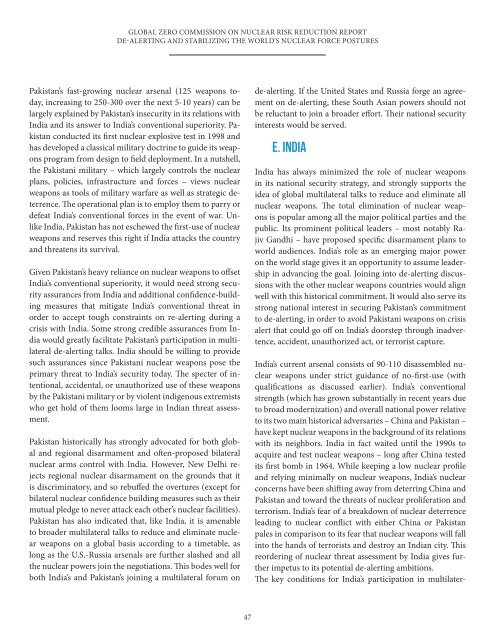global_zero_commission_on_nuclear_risk_reduction_report
global_zero_commission_on_nuclear_risk_reduction_report
global_zero_commission_on_nuclear_risk_reduction_report
Create successful ePaper yourself
Turn your PDF publications into a flip-book with our unique Google optimized e-Paper software.
GLOBAL ZERO COMMISSION ON NUCLEAR RISK REDUCTION REPORTDE-ALERTING AND STABILIZING THE WORLD’S NUCLEAR FORCE POSTURESPakistan’s fast-growing <strong>nuclear</strong> arsenal (125 weap<strong>on</strong>s today,increasing to 250-300 over the next 5-10 years) can belargely explained by Pakistan’s insecurity in its relati<strong>on</strong>s withIndia and its answer to India’s c<strong>on</strong>venti<strong>on</strong>al superiority. Pakistanc<strong>on</strong>ducted its first <strong>nuclear</strong> explosive test in 1998 andhas developed a classical military doctrine to guide its weap<strong>on</strong>sprogram from design to field deployment. In a nutshell,the Pakistani military – which largely c<strong>on</strong>trols the <strong>nuclear</strong>plans, policies, infrastructure and forces – views <strong>nuclear</strong>weap<strong>on</strong>s as tools of military warfare as well as strategic deterrence.The operati<strong>on</strong>al plan is to employ them to parry ordefeat India’s c<strong>on</strong>venti<strong>on</strong>al forces in the event of war. UnlikeIndia, Pakistan has not eschewed the first-use of <strong>nuclear</strong>weap<strong>on</strong>s and reserves this right if India attacks the countryand threatens its survival.Given Pakistan’s heavy reliance <strong>on</strong> <strong>nuclear</strong> weap<strong>on</strong>s to offsetIndia’s c<strong>on</strong>venti<strong>on</strong>al superiority, it would need str<strong>on</strong>g securityassurances from India and additi<strong>on</strong>al c<strong>on</strong>fidence-buildingmeasures that mitigate India’s c<strong>on</strong>venti<strong>on</strong>al threat inorder to accept tough c<strong>on</strong>straints <strong>on</strong> re-alerting during acrisis with India. Some str<strong>on</strong>g credible assurances from Indiawould greatly facilitate Pakistan’s participati<strong>on</strong> in multilateralde-alerting talks. India should be willing to providesuch assurances since Pakistani <strong>nuclear</strong> weap<strong>on</strong>s pose theprimary threat to India’s security today. The specter of intenti<strong>on</strong>al,accidental, or unauthorized use of these weap<strong>on</strong>sby the Pakistani military or by violent indigenous extremistswho get hold of them looms large in Indian threat assessment.Pakistan historically has str<strong>on</strong>gly advocated for both <str<strong>on</strong>g>global</str<strong>on</strong>g>and regi<strong>on</strong>al disarmament and often-proposed bilateral<strong>nuclear</strong> arms c<strong>on</strong>trol with India. However, New Delhi rejectsregi<strong>on</strong>al <strong>nuclear</strong> disarmament <strong>on</strong> the grounds that itis discriminatory, and so rebuffed the overtures (except forbilateral <strong>nuclear</strong> c<strong>on</strong>fidence building measures such as theirmutual pledge to never attack each other’s <strong>nuclear</strong> facilities).Pakistan has also indicated that, like India, it is amenableto broader multilateral talks to reduce and eliminate <strong>nuclear</strong>weap<strong>on</strong>s <strong>on</strong> a <str<strong>on</strong>g>global</str<strong>on</strong>g> basis according to a timetable, asl<strong>on</strong>g as the U.S.-Russia arsenals are further slashed and allthe <strong>nuclear</strong> powers join the negotiati<strong>on</strong>s. This bodes well forboth India’s and Pakistan’s joining a multilateral forum <strong>on</strong>de-alerting. If the United States and Russia forge an agreement<strong>on</strong> de-alerting, these South Asian powers should notbe reluctant to join a broader effort. Their nati<strong>on</strong>al securityinterests would be served.E. INDIAIndia has always minimized the role of <strong>nuclear</strong> weap<strong>on</strong>sin its nati<strong>on</strong>al security strategy, and str<strong>on</strong>gly supports theidea of <str<strong>on</strong>g>global</str<strong>on</strong>g> multilateral talks to reduce and eliminate all<strong>nuclear</strong> weap<strong>on</strong>s. The total eliminati<strong>on</strong> of <strong>nuclear</strong> weap<strong>on</strong>sis popular am<strong>on</strong>g all the major political parties and thepublic. Its prominent political leaders – most notably RajivGandhi – have proposed specific disarmament plans toworld audiences. India’s role as an emerging major power<strong>on</strong> the world stage gives it an opportunity to assume leadershipin advancing the goal. Joining into de-alerting discussi<strong>on</strong>swith the other <strong>nuclear</strong> weap<strong>on</strong>s countries would alignwell with this historical commitment. It would also serve itsstr<strong>on</strong>g nati<strong>on</strong>al interest in securing Pakistan’s commitmentto de-alerting, in order to avoid Pakistani weap<strong>on</strong>s <strong>on</strong> crisisalert that could go off <strong>on</strong> India’s doorstep through inadvertence,accident, unauthorized act, or terrorist capture.India’s current arsenal c<strong>on</strong>sists of 90-110 disassembled <strong>nuclear</strong>weap<strong>on</strong>s under strict guidance of no-first-use (withqualificati<strong>on</strong>s as discussed earlier). India’s c<strong>on</strong>venti<strong>on</strong>alstrength (which has grown substantially in recent years dueto broad modernizati<strong>on</strong>) and overall nati<strong>on</strong>al power relativeto its two main historical adversaries – China and Pakistan –have kept <strong>nuclear</strong> weap<strong>on</strong>s in the background of its relati<strong>on</strong>swith its neighbors. India in fact waited until the 1990s toacquire and test <strong>nuclear</strong> weap<strong>on</strong>s – l<strong>on</strong>g after China testedits first bomb in 1964. While keeping a low <strong>nuclear</strong> profileand relying minimally <strong>on</strong> <strong>nuclear</strong> weap<strong>on</strong>s, India’s <strong>nuclear</strong>c<strong>on</strong>cerns have been shifting away from deterring China andPakistan and toward the threats of <strong>nuclear</strong> proliferati<strong>on</strong> andterrorism. India’s fear of a breakdown of <strong>nuclear</strong> deterrenceleading to <strong>nuclear</strong> c<strong>on</strong>flict with either China or Pakistanpales in comparis<strong>on</strong> to its fear that <strong>nuclear</strong> weap<strong>on</strong>s will fallinto the hands of terrorists and destroy an Indian city. Thisreordering of <strong>nuclear</strong> threat assessment by India gives furtherimpetus to its potential de-alerting ambiti<strong>on</strong>s.The key c<strong>on</strong>diti<strong>on</strong>s for India’s participati<strong>on</strong> in multilater-47


